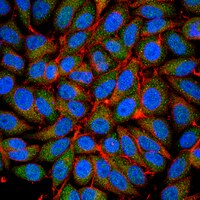β-catenin inhibitor ICAT modulates the invasive motility of melanoma cells.
Domingues, MJ; Rambow, F; Job, B; Papon, L; Liu, W; Larue, L; Bonaventure, J
Cancer research
74
1983-95
2014
Mostrar resumen
Inhibitor of β-catenin and TCF (ICAT) inhibits β-catenin transcriptional activity by competing with T-cell factor/lymphoid enhancer factor. We documented high ICAT levels in human melanoma cells, in which β-catenin signaling is frequently deregulated, finding a correlation with the capacity to form metastases in nude mice. Ectopic expression of ICAT in melanoma cells did not affect their proliferation but increased cell motility and Matrigel invasion of metastatic cells in a manner relying upon stable ICAT-β-catenin interaction. This effect was associated with conversion of an elongated/mesenchymal phenotype to a round/amoeboid phenotype in the absence of similar effects on elongated morphology of nonmetastatic melanoma cells. Transition from mesenchymal to amoeboid movement was associated with decreased levels of NEDD9 and activated Rac1, a positive regulator of mesenchymal movement. Ectopic ICAT promoted colonization of melanoma cells in the lungs of nude mice, suggesting an increase in metastatic potential. Together, our results showed that by downregulating Rac signaling in metastatic melanoma cells, ICAT increased their invasive motility by promoting a morphologic variation that facilitates a favorable adaptation to their microenvironment. | 24514042
 |


















